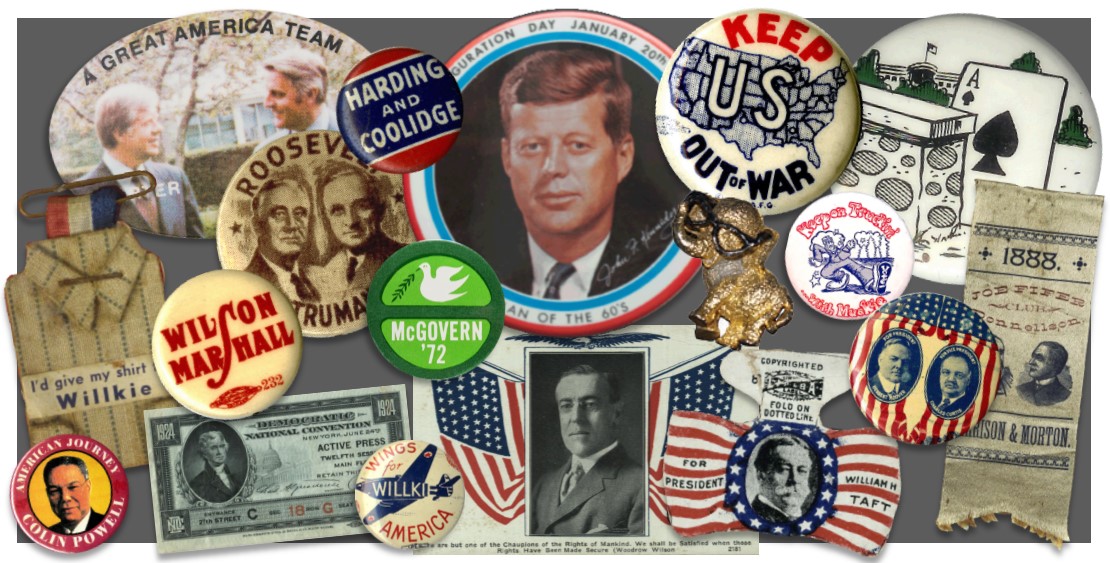
M-322: The Dr. Allen B. and Helen S. Shopmaker American Political Collection
The Dr. Allen B. and Helen S. Shopmaker American Political Collection illustrates the complexities of campaigning and electing the president of the United States. With over three thousand items, the collection reflects American society’s changing tastes and attitudes towards presidential candidates. Featuring a range of items including ribbons, buttons, bumper-stickers, ceramics, and ephemera, this material culture collection complements the Mercantile Library’s growing collection of documents about our nation’s political history. The Shopmaker campaign memorabilia expands the Mercantile Library’s existing research opportunities for our university, community, and national audiences. We are grateful to Helen Shopmaker for the generous gift of this collection and the endowment that enables us to make it available in the ongoing gallery exhibitions and online through the UMSL Digital Library.
Exhibitions:
The Shopmaker Gallery features changing focused exhibitions exploring aspects of the collection. Past exhibitions have included “Whistle Stops: Campaigning by Train”, “Presidents and War”, and “100 Million Buttons Can’t Be Wrong.” The Shopmaker Political Print Gallery explores the many ways politics is reflected in American print culture through changing thematic exhibitions. The inaugural exhibition was a comprehensive installation of all available prints by Missouri’s noted artist and politician, George Caleb Bingham, followed by an installation of political cartoons and the current series of presidential portrait exhibitions. Check the Mercantile Library website Exhibitions page for information on the current exhibitions.
Highlights of the Collection:
Campaign buttons— The earliest forms of buttons included brass clothing buttons and paper tabs. The modern-day pinback button became popular later, varying in size, shape, and complexity. The collection includes rare and unique buttons such as the “gold bug” with moveable wings featuring photographic portraits of the candidates supporting the gold standard. Modern and contemporary buttons include flashers – holographic images that alternate when the button is moved – and one candidate’s button issued in Braille.
Commodities—Manufacturing companies have long been aware of the ability to sell products by including an image, or even the name, of the president or a candidate. Some of the earlier items in this category included in the collection are playing cards, glass and ceramic plates, spoons, and straight razors. By the mid-20th century, cigars, matchbooks, and soda bottles referenced the president, while modern examples in the collection include cappuccino canisters, soap, and of course t-shirts.
Portraits— Images of the presidential candidates are found on a broad range of campaign memorabilia, from buttons to posters to handkerchiefs. Campaign portraits reflect how the candidate wished to be seen, and the changes in pose, dress, and mood of the images is a revealing study of how Americans felt about their candidates. The collection features numerous examples of jugates, the traditional format for paired portraits with the presidential and vice-presidential candidates featured side-by-side, and many other conventional and innovative portraits in a variety of media.
Political Cartoons—Often employing caricature and allusion, political cartoons show both support and discontent with presidents and potential candidates. Examples of political cartoons in the collection date from the early 19th century through the modern day and include works by well-known national and local artists including Thomas Nast, Joseph Keppler, and Daniel Fitzpatrick.
Sheet Music—Political songs became a popular mode of campaigning, especially in the 1900s. Sheet music covers often feature a portrait of the candidate, while the lyrics outline his many attributes or simply urge the listener to get out and vote. The collection features examples from the 19th and 20th centuries.
Textiles—Some of the oldest campaign memorabilia in the United States are ribbons. Like their modern equivalent, bumper-stickers, supporters wore ribbons to exhibit their political preferences in the 19th-century. In addition to ribbons, campaigns have used functional textiles including scarves, hats, and handkerchiefs to extol the merits of their candidate. The collection includes rare early 19th century ribbons and silk campaign sash, handkerchiefs, bandanas, scarves and neckties.
Voting Equipment and Ephemera – At the heart of any election is the act of voting. The collection features a growing assortment of objects related to the process of voting, including an 1824 presidential election hand-written ledger of electoral candidates for St. Louis County, as well as a 2000 Florida voting booth.
Research Opportunities:
Political history is represented in many areas of the Mercantile Library’s deep regional and national collections from presidential letters to the photo and clipping archive of the St. Louis Globe-Democrat. See the Opportunities for Researching American Political History (2 Pages, 1 MB, PDF) brochure or submit a Research Request for further assistance. Those wishing to learn more about the political items may view selections from the Collection on the UMSL Digital Library, or contact the curator, Nick Fry, by email at fryn@umsl.edu or by phone at 314-516-7253. The Library welcomes donations of appropriate materials related to the Shopmaker collections. Those wishing to donate should contact the curator to begin the review process.
